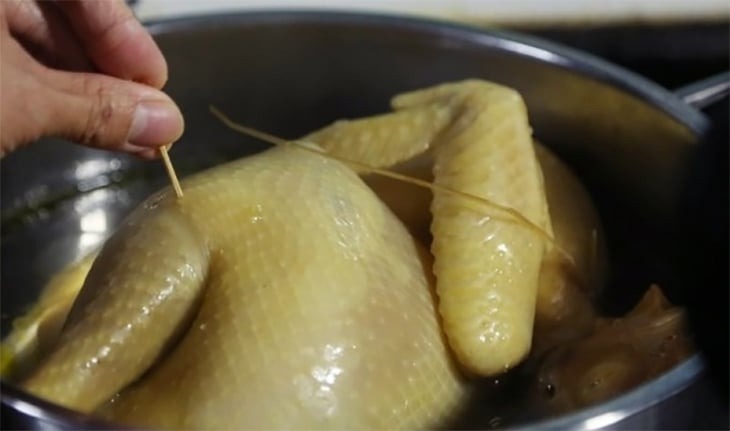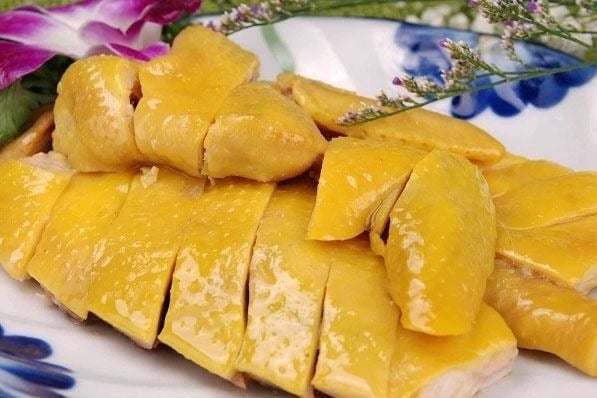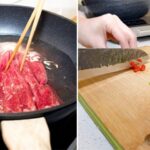Poached chicken is a traditional and popular dish in Vietnamese cuisine, often gracing family meals, festive occasions, or special celebrations. Despite its seemingly simple preparation, achieving the perfect poach, with tender and flavorful meat, can be a challenging endeavor. Many home cooks struggle with preparing poached chicken, encountering issues such as bland meat, cracked skin, or a less-than-desirable taste.
To avoid these pitfalls, poaching chicken requires attention to detail and adherence to the following four critical steps. By following these steps diligently, you will be rewarded with a delectable bowl of poached chicken, boasting juicy meat, a perfect texture that is neither too tough nor too flaky, and, most importantly, a delightful flavor profile.
Why Poach Chicken in Boiling Water?
For a flawless poach, it is imperative to begin by cleaning the chicken thoroughly by plucking and rinsing it inside out. Subsequently, bring a pot of water to a rolling boil and infuse it with chopped scallions and ginger. Scallions and ginger not only enhance the aroma of the dish but also help eliminate any unpleasant odor from the chicken.
Once the water has reached a vigorous boil, gently place the chicken into the pot. At this stage, the poaching liquid will absorb the flavors of the scallions and ginger, effectively neutralizing any lingering odor. It is a common misconception to submerge the chicken in cold water or wait for the water to boil before adding the chicken. However, both methods are incorrect. Immersing the chicken in cold water will result in tough skin, while placing it in already boiling water may cause the skin to shrink and crack, detracting from the aesthetics of the dish.

The Three-Dip Technique
After placing the chicken in the boiling water, remove it after a few seconds and return it to the hot liquid. Repeat this process two more times. This technique acclimates the chicken to the hot water, preventing skin rupture while enhancing the flavor of the meat.
Next, cover the pot and continue cooking for 20 minutes. Once the chicken is cooked, transfer it to a bowl of cold water. This step ensures a crispier skin with a brighter, more appealing color, making your poached chicken presentation-worthy.
A Less is More Approach to Seasoning
Resist the temptation to overload on seasonings to mask any off-putting odors. Chicken has its own innate fragrance and natural sweetness. Over-seasoning can overpower these delicate flavors. When poaching chicken, a few slices of ginger and a sprig of scallion are sufficient to neutralize any unwanted smells, along with a pinch of salt if desired.
Timing is Everything: The Optimal Poaching Duration
For tender and juicy meat, take care not to overcook the chicken, as it will result in dry and tough flesh. Utilize a pot that is sufficiently tall and wide to ensure even cooking. For a chicken weighing between 1.5 to 2 kilograms, an ideal pot diameter would be 28 centimeters.
Using a pot that is too large may cause the chicken to shrink and appear less appealing, while a pot that is too small may lead to uneven cooking. To poach the chicken, bring the water to a boil and then reduce the heat to low. Avoid a vigorous flame, as it can cause the chicken skin to shrink and crack, and overcooking will render the skin soggy and the meat unappetizing. The optimal poaching time falls between 20 to 30 minutes.
Achieving a Golden Hue: A Culinary Secret
Prior to poaching, you can impart a golden luster to the chicken’s skin by combining approximately 20-30 ml of chicken fat, rendered from pan-frying, with turmeric. Apply this mixture to the surface of the chicken. If using fresh turmeric, after skimming the fat, scoop out the chicken fat and blend it with the turmeric, briefly heating the mixture for 30 seconds to a minute. Then, turn off the heat and use this infused fat to baste the chicken.

Enhance the aesthetics of your poached chicken by creating a golden sheen using chicken fat and turmeric.
If you opt for turmeric powder, pour the powder into a small bowl or cup and add the hot chicken fat, stirring to combine. Allow the fat to settle, and then use this infused mixture to brush onto the chicken’s surface. This technique imparts an attractive golden hue without overwhelming the flavor of the turmeric, which could occur if applied directly to the poaching liquid. Once the chicken is poached and removed from the liquid, let it drain and then apply this turmeric-infused fat to its surface. When sliced, the chicken will present a visually appealing and mouthwatering sight.
The Magic Sprinkle: Keep Your Ginger Fresh for a Year and Beyond
Introducing the ultimate guide to storing ginger root. Are you tired of your ginger going bad before you get a chance to use it? Well, worry no more! We’ve got the top tips and tricks to keep your ginger fresh and flavorful for longer. From freezing to storing in syrup, we’ll reveal the best methods to ensure your ginger stays in tip-top condition.






































